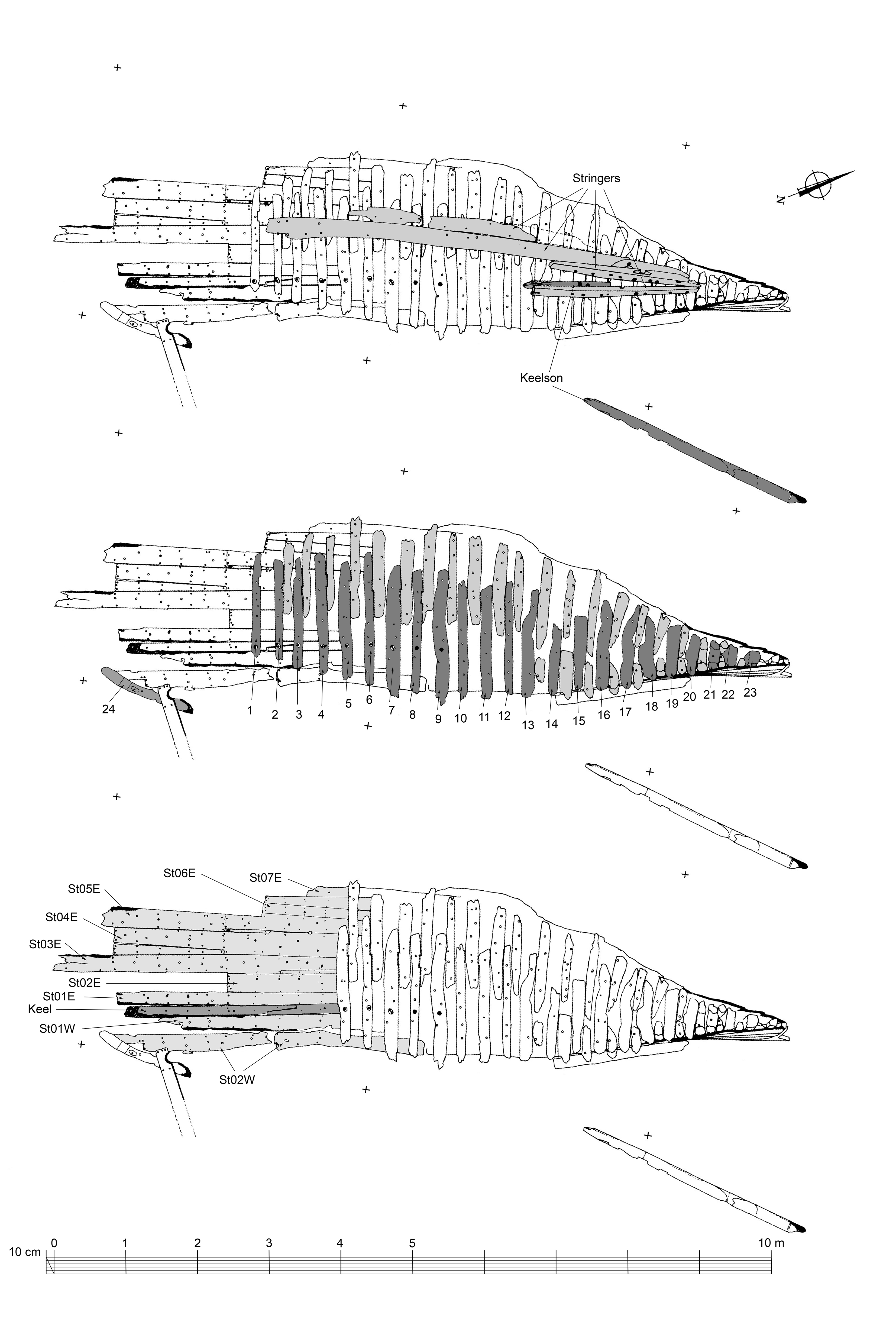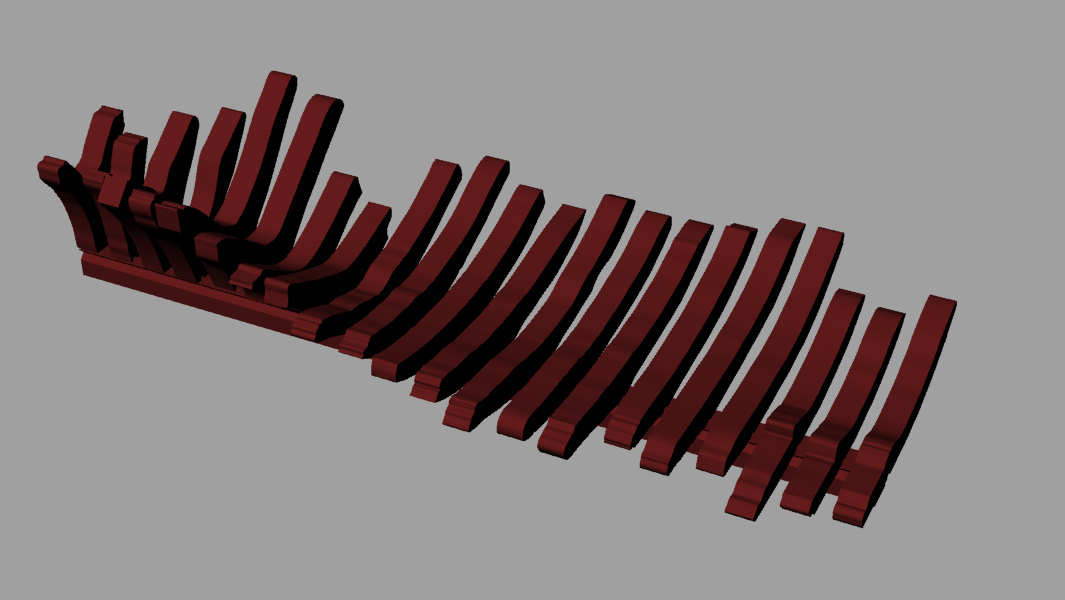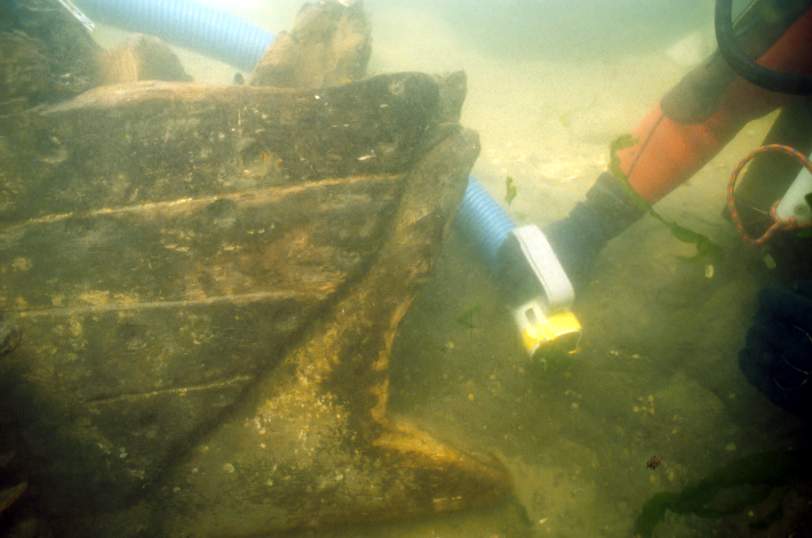Aveiro A Shipwreck (c. 1475)
Filipe Castro
Country: Portugal
Place: Ria de Aveiro
Coordinates (approximate): Lat. ; Long.
Type: Small merchant vessel
Identified: No
Dated: Circa 1475
Introduction
The remains of a small boat were exposed during low tide at Ria de Aveiro, in one of the margins of the Mira River estuary, and reported by a local fisherman in 1992. The ceramics in the cargo suggested a date on the fourth quarter of the 15th century. Radiocarbon dates from the hull timbers, a barrel, and some organic materials, seemed to cluster slightly earlier, around 1450, suggesting a date for this ship around the third quarter of the 15th century (Alves et al. 2001b).

Preliminary analysis of the timber components suggested that it was built with local timber, possibly oak (Quercus sp.).
The identity, size, and type of this ship are also unknown. Like the Corpo Santo ship, this vessel may have been built in Portugal, since it was carrying a local cargo and its scantlings suggest a relatively small vessel.
Team
The Aveiro A shipwreck was excavated, conserved and studied by a team from the National Museum of Archaeology (MNA), under the direction of Francisco Alves, and then by the national agency for nautical archaeology, when it was created, in 1997, and absorbed the MNA team.
The project was taken over by Centro de Estudos de Além Mar, Universidade Nova de Lisboa, and it is still ongoing.
Story of the Ship
The story of this vessel is unknown.
Loss
It is not known how this vessel was lost.
Tumulus
The remains covered an area of around 10.4 x 2.5 m and corresponded to the after portion of the starboard bottom of the hull.
Ballast
The ballast has not been studied.
Anchors
There were no anchors near the site.
Guns
There were no guns, or any type of weapons on this site.
Hull Remains
The surviving timbers included two pieces of the keel, a stern heel, a stern knee, remains of 23 frames in place and one displaced, hull planking, two stringers, and a portion of the keelson, which was found displaced nearby. Grooves carved on the upper surface of the keelson to receive the stanchion tenons indicate the presence of a fixed deck.

It is difficult to describe this shipwreck because there is no published timber catalogue.
Scantlings
Table 1. Scantlings of the Aveiro A Shipwreck
| Timber | Sided
[cm] |
Molded
[cm] |
| Keel | 12 | 12 |
| Keelson | 13 | 12.5 |
| Sternpost | 11 | ? |
| Floor timbers | 12 | 12.5 |
| First futtocks | 12 | 12.5 |
| Room-and-space | 33 | – |
| Planking | 22/33 | 5.5 |
| Stringers | 24/30 | 5/6 |
Keel
The keel was rabbeted and preserved along 9.15 m. The two components preserved were connected with a flat vertical scarf, with a table of 40 cm under frames numbers 02 through 04. The aft keel component was connected to the stern heel with a similar flat vertical scarf, under frames 16 through 21.
Stem
The stem was not preserved.
Stern

The stern heel presented a characteristic skeg and was preserved to a height of 74 cm, counting from the base of the keel. The sternpost rake was around 27°, although its rounded shape makes this angle difficult to measure. It is possible that this vessel had a round tuck.
Frames
Remains of 24 frames survived, and the fastener marks of another four were clearly visible on the hull planking, forward of frame 01. All surviving futtocks are placed on the stern face of each floor timber, in a manner characteristic to the Mediterranean and the Iberian shipbuilding traditions. The fasteners’ marks on the planking suggest that timber number 01 was composed of one floor timber and four futtocks, two on each side, and that forward of it all futtocks were placed on the forward face of their respective floor timbers. This suggests that frame 01 is the master frame, even though its forward futtocks were not fastened to the floor timber.
Roman numerals incised in three frames reinforce the supposition that frame 01 is the master frame: frame number 5 with a “V” on its aft face, number 12 with a “XII” on its forward face, and number 15 with a “XV” on its upper face.
Furthermore, the frame assemblage can be divided in two groups, the first encompassing the eight central frames, with the futtocks scarved to the floor timbers, and the second the remaining the v- and y-shaped floor timbers, which in Portugal were called enchimentos and fastened to the keel without the futtocks.
The eight central frames were mounted on the keel with pre-assembled futtocks, fastened to the floor timbers with rectangular scarves, two treenails and two iron nails, plus one iron nail on the futtock extremity.
In the frames preserved, the mortise was carved on the floor timber, in all cases but one, frame 04, and all mortises were rectangular.
Floors were fastened to the keel with a vertical iron nail, except frame number 02, placed over the forward keel scarf, which was nailed to both components of the keel. Floor timbers 1 through 3 had buttresses carved on their upper surfaces to support the keelson laterally.
The v- and y-shaped floors (enchimentos), numbered 9 through 23, were fastened to the keel with one nail inserted in a triangular incision carved on the face of the floor timber, except floor timber number 09, which was fastened to the keel in the same way as the central frames. Floor timbers 10 to 18 were nailed to the keel from the forward face, 19, 20, and 21 from the aft face, and 22 and 23 again from the forward face. Floor timbers 09 through 19 did not have dovetail scarves and were fastened to their respective futtocks with two oblique iron nails, inserted with them in place.
All frames were roughly cut and presented sapwood and waney edges.
Keelson
The keelson was preserved along 4.65 m, and was originally fastened to the keel with iron bolts Ø = 2.5 cm, placed before and after the keel scarves, and nailed to every fourth or fifth floor timber. It was notched underneath to receive some of the floor timbers, and had three sloths on its upper face to receive movable stanchions.
Planking
The planking was 5 to 5.5 cm thick and the planks were nailed to the frames with one to three iron nails.
Although no planking plan has been published, the planks that are shown in the hull plan pose an interesting problem: strake St04E seems to become wider towards the southern end of the shipwreck, having what seems like a repair (or a stealer). This is implausible if frame No. 1 is the midship frame.
Stringers
The remains of two stringers were preserved in situ, one measuring 30 x 5 cm.
Caulking
No caulking remains were found at the time.
Fasteners
All iron fasteners had square shanks measuring around 15 mm on a side, and the stringers were fastened with smaller nails, around 9 mm square. The treenails measured Ø = 2.2 cm, and the iron bold preserved had a round section with Ø = 2.5 cm.
Wood
Preliminary analysis of the timber components suggested that it was built with timber from local trees, possibly oak (Quercus sp.). Timber samples were carbon dated to c. 1450, perhaps sometime later (1 sigma: 1434-1448 cal AD; for 2 sigma: 1424-1469 cal AD). The remains were removed, disassembled, studied, partially published, and conserved.
Cargo
The cargo was studied and published, consisting mainly of local ceramics and dry fruits.
Personal Items
None reported.
Rigging
We do not know what type of rigging this ship carried.
Reconstruction
Preliminary analysis suggests that the ship’s keel was 12.32 m long, or 8 rumos (1 rumo = 1.54 m), and that the master frame was placed 1/8 of the keel length forward of the middle of the keel (Alves et al. 2001b, 329).
The maximum flat of the floor timber seems to have been around 2.5 m, a measure that is consistent with a maximum beam of 1/3 to 1/2 of the keel length, or 4.16 to 6.16 m.
An interesting feature of this vessel is that frames 01 through 05 don’t rise nor narrow (pers. comm. Miguel Aleluia) and the remains of the displaced frame found to bow and believed to be frame V forward suggest that this was also the case forward.
A reconstruction of this shipwreck has been in the making for about two decades now.
Beam: Estimated 4.16 m.
Keel Length: Estimated 12.32 m.
Length Overall: Estimated 17-18 m.
Number of Masts: Unknown.
Publications
Francisco Alves, Eric Rieth, Paulo Rodrigues, Miguel Aleluia, Ricardo Rodrigo, and Catarina Garcia, 2001. “The Hull Remains of Ria de Aveiro A, a Mid-15th Century Shipwreck from Portugal: a Preliminary Analysis,” in Proceedings of the International Symposium ‘Archaeology of Medieval and Modern Ships of Iberian-Atlantic Tradition’, ed. Francisco Alves. Lisbon: Instituto Português de Arqueologia.
Francisco Alves, P. Rodrigues, M. Aleluia, R. Rodrigo, C. Garcia, E. Rieth, and E. Riccardi, 2001. “Ria de Aveiro A: a Shipwreck from Portugal Dating to the Mid-15th Century; a Preliminary Report,” International Journal of Nautical Archaeology 30.1: 12–36.
